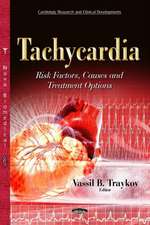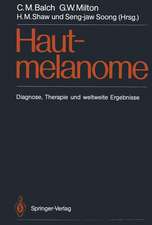Drug Development for Cancer and Diabetes: A Path to 2030
Editat de K. Saravanan, Chukwuebuka Egbuna, Horne Iona Averal, S. Kannan, S. Elavarasi, Bir Bahaduren Limba Engleză Paperback – 28 feb 2022
- Details the role of plants for the treatment and management of cancer and diabetes
- Discusses the role of phytocompounds as ligands for cancer and diabetic targets
- Reviews plants and the potential of phytochemicals as antidiabetic and anticancer drugs
- Explores the green biosynthesis of nanoparticles and their treatment efficiency
| Toate formatele și edițiile | Preț | Express |
|---|---|---|
| Paperback (1) | 580.08 lei 3-5 săpt. | +27.17 lei 7-11 zile |
| Apple Academic Press Inc. – 28 feb 2022 | 580.08 lei 3-5 săpt. | +27.17 lei 7-11 zile |
| Hardback (1) | 794.34 lei 6-8 săpt. | |
| Apple Academic Press Inc. – 31 aug 2020 | 794.34 lei 6-8 săpt. |
Preț: 580.08 lei
Preț vechi: 637.46 lei
-9% Nou
Puncte Express: 870
Preț estimativ în valută:
111.01€ • 120.54$ • 93.25£
111.01€ • 120.54$ • 93.25£
Carte disponibilă
Livrare economică 01-15 aprilie
Livrare express 18-22 martie pentru 37.16 lei
Preluare comenzi: 021 569.72.76
Specificații
ISBN-13: 9781774634936
ISBN-10: 1774634937
Pagini: 392
Ilustrații: 31 Tables, black and white; 13 Illustrations, color; 32 Illustrations, black and white
Dimensiuni: 156 x 234 x 24 mm
Greutate: 0.64 kg
Ediția:1
Editura: Apple Academic Press Inc.
Colecția Apple Academic Press
ISBN-10: 1774634937
Pagini: 392
Ilustrații: 31 Tables, black and white; 13 Illustrations, color; 32 Illustrations, black and white
Dimensiuni: 156 x 234 x 24 mm
Greutate: 0.64 kg
Ediția:1
Editura: Apple Academic Press Inc.
Colecția Apple Academic Press
Public țintă
Academic and PostgraduateCuprins
PART I CANCER AND LEADS FOR CANCER TREATMENT 1. Biomarkers for Screening of Premalignant Lesions and Therapeutic Surveillance 2. Kinase Targets in Cancer Drug Discovery 3. Essential Drug Properties and Stages in Anti-Cancer Drug Development 4. Plant Constituent as Anti-Cancer Drugs 5. Anticancer Properties of Some Effective Phytochemicals 6. Therapeutic Aspects of Some Extracts and Purified Cardiac Glycosides Obtained From Nerium oleander L 7. Challenging Compounds of Some Medicinal Plants Against Cancer 8. Medicinal Plants as Therapeutic Agents in the Treatment of Cancer 9. Cytotoxic, Apoptosis Inducing Effects and Anti-Cancerous Drug Candidature of Jasmonates 10. Apoptosis Activity of 1,2,-Benzene Dicarboxylic Acid Isolated from Andrographis paniculata on KB, SiHa and IMR Cancer Cell Line 11. Anticancer Drug Discovery From the Indian Spice Box 12. Phytochemical Investigation and Evaluation of Anti-Breast Cancer Activity of Chloroform Extract of Tagetes erecta 13. Isolation, Identification and In Silico Evaluation of Anticancer Activity of Flavone from Pisum sativum 14. Functional Lead Phytochemicals from the Rutaceae and Zingeiberaceae Plants for Development of Anticancer Drugs 15. In Vitro Anticancer Activity of Biophytum sensitivum on Liver Cancer Lines (HEPG2) 16. Saffron and Its Active Ingredients: A Natural Product with Potent Anticancer Property PART I: ANTIDIABETIC DRUG DISCOVERY 17. Effects of Pterocarpus marsupium in the Management of Type 2 Diabetes Mellitus 18. Antidiabetic and Antihyperlipidemic Activities of Cyathea nilgiriensis (Holttum) on STZ Induced Diabetic Rats 19. Antidiabetic Activity of Drug Loaded Chitosan Nanoparticle 20. Antidiabetic Activity of Silver Nanoparticles Biosynthesized Using Ventilago maderaspatana Leaf Extract 21. Hypoglycemic Activity of Biophytum sensitivum Whole Plant Extracts on Alloxan Induced Diabetic Rats 22. Antidiabetic Activity of Ventilago maderaspatana Leaf Extracts on STZ Induced Diabetic Rats 23. Isolation, Identification, and Molecular Docking of Antidiabetic Compounds of Cyatheia nilgiriensis (Holttum) 24. Antidiabetic Potentials of Major Indian Spices: A Review 25. Aloe Species: Chemical Composition and Therapeutic Uses in Diabetic Treatment
Notă biografică
K. Saravanan, PhD, is Associate Dean of Academic Affairs and Assistant Professor of Zoology, Nehru Memorial College, an affiliated institution of Bharathidasan University, Tamilnadu, India. He has been engaged in teaching, research, and writing for over 15 years.
Chukwuebuka Egbuna is a chartered chemist, a chemical analyst, and an academic researcher. He has had many roles at New Divine Favor Pharmaceutical Industry Limited, Nigeria, and Chukwuemeka Odumegwu Ojukwu University, Nigeria. He has published research articles on phytochemistry as well as the 3-volume book Phytochemistry with AAP.
Horne Iona Averal, PhD, is Associate Professor at Holy Cross College, Trichy, India. She has received many awards and honors and has been engaged with many academic roles at several colleges and universities. Dr. Averal has published four nucleotide sequences in the NCBI-GENBANK.
S. Kannan, PhD, is a specialist in cancer biology and nanomedicine. He has held many roles at national and international academic and scientific bodies and has published a large number of research articles and books in his field.
S. Elavarasi, PhD, is Assistant Professor at Holy Cross College, an affiliated institution of Bharathidasan University, Tamilnadu, India. She has been engaged in teaching and research for more than eight years. She has published research articles, book chapters, and books.
Bir Bahadur, PhD, was formerly Professor, Chairman, and Head of the Department, as well as Dean of the Faculty of Science at Kakatiya University in Warangal, India. A prolific writer and editor, he received many awards and honors during his long career, including being named as an Eminent Botanist of India.
Chukwuebuka Egbuna is a chartered chemist, a chemical analyst, and an academic researcher. He has had many roles at New Divine Favor Pharmaceutical Industry Limited, Nigeria, and Chukwuemeka Odumegwu Ojukwu University, Nigeria. He has published research articles on phytochemistry as well as the 3-volume book Phytochemistry with AAP.
Horne Iona Averal, PhD, is Associate Professor at Holy Cross College, Trichy, India. She has received many awards and honors and has been engaged with many academic roles at several colleges and universities. Dr. Averal has published four nucleotide sequences in the NCBI-GENBANK.
S. Kannan, PhD, is a specialist in cancer biology and nanomedicine. He has held many roles at national and international academic and scientific bodies and has published a large number of research articles and books in his field.
S. Elavarasi, PhD, is Assistant Professor at Holy Cross College, an affiliated institution of Bharathidasan University, Tamilnadu, India. She has been engaged in teaching and research for more than eight years. She has published research articles, book chapters, and books.
Bir Bahadur, PhD, was formerly Professor, Chairman, and Head of the Department, as well as Dean of the Faculty of Science at Kakatiya University in Warangal, India. A prolific writer and editor, he received many awards and honors during his long career, including being named as an Eminent Botanist of India.
Recenzii
“This book extrapolates the recent advancements, emerging trends, and novel innovations and speculates about the future perspective in the discovery of drugs for the treatment of cancer and diabetes. As a complete package for the readers, this book provides a valuable window on the revolutionary sector of drug discovery. Part I and Part II of the book together provides comprehensive content to understand the theoretical aspect as well as practical advances and research discoveries. The novel approach of depicting the role of plants and the potential of phytochemi¬cals as antidiabetic and anticancer drugs is a key feature.”
—From the Foreword by Dr. P. Padmanabhan, Deputy Director, Lee Kong Chian School of Medicine, Nanyang Technological University, Singapore
—From the Foreword by Dr. P. Padmanabhan, Deputy Director, Lee Kong Chian School of Medicine, Nanyang Technological University, Singapore
Descriere
Drug Development for Cancer and Diabetes: A Path to 2030 focuses on new developments in the discovery of drugs for the treatment of cancer and diabetes. This new book presents important recent advances, emerging trends, and novel innovations for these two world-leading diseases.


























